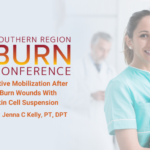Abstract | December 20, 2021
Early Post-Operative Mobilization After Treatment of Burn Wounds With Autologous Skin Cell Suspension
Learning Objectives
- Demonstrate the need for standardized clinical practice guidelines regarding post-operative mobilization after autografting.
- Describe potential mobilization techniques for the post-operative application of autologous skin cell suspension with polylactic acid sheet.
Introduction:
Early mobilization has become an increasingly popular topic in burn care over the last decade. The many benefits of early mobilization in critically ill patients are welldocumented in the literature and include decreased ventilator days, decreased hospital and ICU length of stay, and improved functional outcomes. However, the term early mobilization is often undefined and varies widely based on practitioner preference. Similarly, clinical practice guidelines regarding post-operative mobilization of patients with burn injury, especially after autografting, are incredibly limited, resulting in significant practice variance among burn centers. Furthermore, data on early mobilization after treatment with autologous skin cell suspension (ASCS), a relatively new FDA-approved therapy, is even more limited, and an even wider variation in practice exists. We hypothesize, with appropriate patient selection, early post-operative mobilization is safe and does not compromise healing or lead to graft loss.
Methods:
A preliminary retrospective chart review was performed to examine mobility interventions utilized for all patients, with mixed partial and full thickness burns, who received ASCS with polylactic acid sheet, with or without meshed splint-thickness skin grafting (STSG), over a six-month period (November 2020 – May 2021) at an academic burn center. Data collection included demographics, operative procedure performed, dressing choice, post-operative restrictions, post-operative date of mobilization by burn therapy, and presence of graft loss (>25% of grafted area with need for regrafting). The data was analyzed to corelate post-operative day mobilization and graft success. Initially, the authors utilized manufacturer splinting guidelines to direct post-operative mobilization before becoming more judicious with aggressive early mobilization. Patients who were at risk of noncompliance and graft sheer were splinted.
Results:
Fifteen patients were included in the study. In those patients, 25 body areas were grafted with 17 areas receiving only ASCS with polylactic acid sheet and 8 areas additionally receiving STSG. On post-operative day (POD) 0, four areas were splinted and no range of motion (ROM) was performed at the joint. The authors splinted 3 out of the 4 patients (75%) due to initial manufacturer splinting guidelines, while the fourth patient was splinted due to compliance concerns and mental health past medical history. For the other 21 areas, active ROM, functional mobility and performance of activities of daily living with functional movement was allowed on POD 0. A dedicated burn therapist actively treated 64% of the patients on POD 0-1 and 100% of the patients were treated by POD 2. Minimal patchy graft loss (median 1.5%) was noted in 6 grafted areas including 1 area which crossed a knee in the previously mentioned immobilized patient. No graft loss was related to post-operative mobilization and was attributed to other factors including infection or wound conversion and, by definition, no significant graft loss was found in this study.
Conclusion:
While the sample size is limited, this study suggests that early post-operative mobilization of ASCS with polylactic acid sheet is safe and does not lead to graft loss. After success with conservative splinting, adaptations were initiated and mobilization was increased with select patients. Considerations for mobilization techniques, such as ROM and functional mobility, should include joint involvement, presence of STSG with ASCS overspray, and other patient factors such as health literacy and compliance. Additional prospective studies should be dedicated to the examination of postoperative mobilization to develop clinical practice guidelines which can be widely utilized across the burn therapy field.

